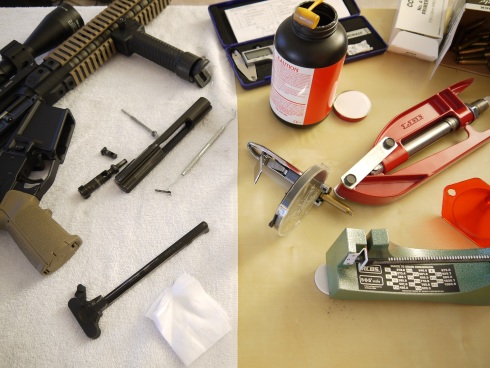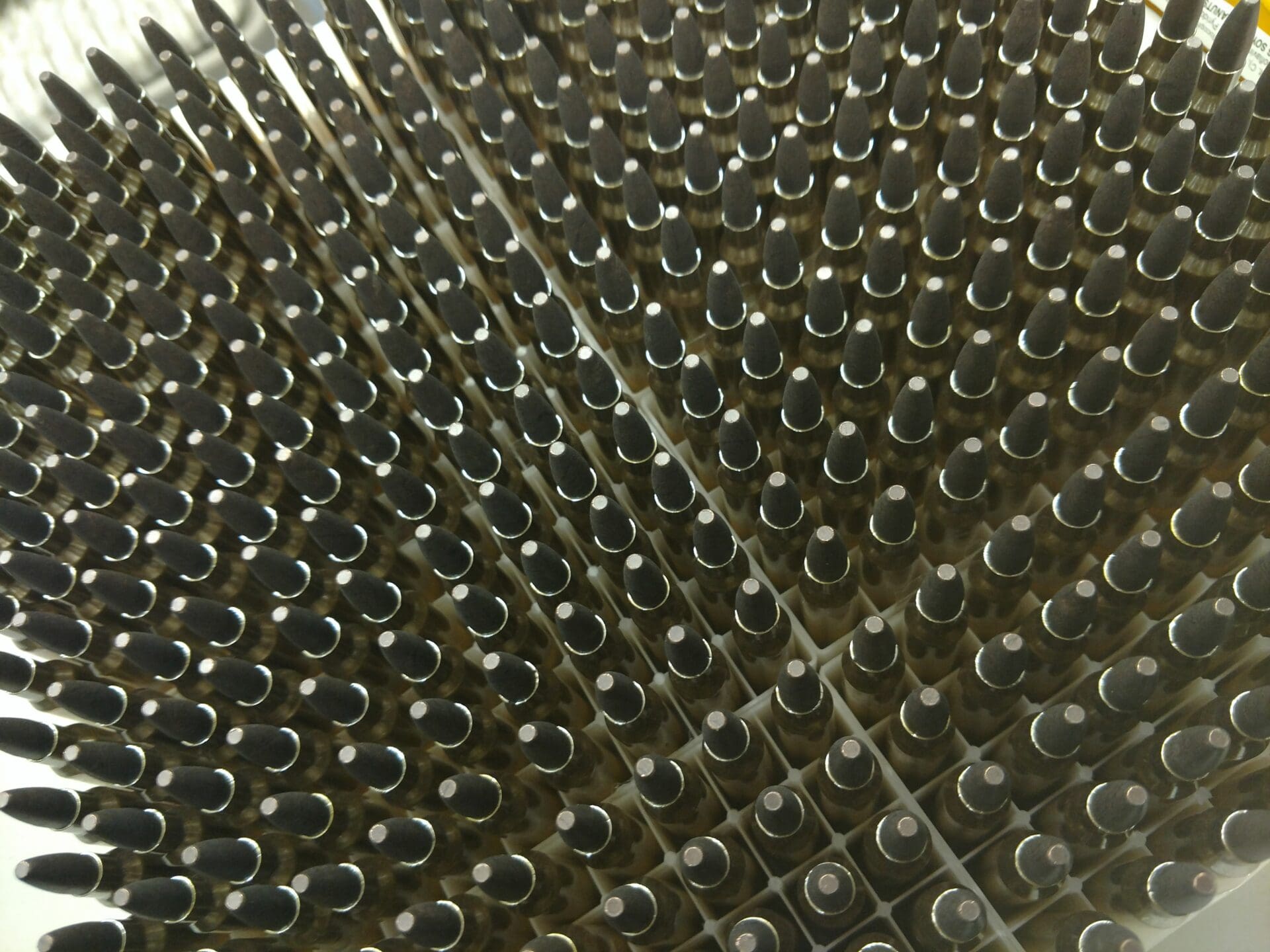
A couple of days ago, RF asked me to join the writing staff at The Truth about Guns. I agreed to become the site’s resident mad scientist. I have a bad/good habit of questioning “accepted knowledge” about guns, whether it be the supposed superiority of FNH’s semi-automatic shotgun offerings or whether Wolf ammunition’s accuracy is correlated with its price (that one you may have seen before). I use science and statistics to get a definite answer instead of relying on gun store scuttlebutt. I have a couple experiments in mind, but I want to hear what TTAG’s Armed Intelligentsia needs to know. To start the conversation, here are a few ideas my friends and I have been kicking around during the past few days . . .
AR-15 Magazine Deathmatch: Magpul 30-round PMAGs, Lancer 30-round translucent magazines, Tapco 3-round magazines, C-Products steel 30-round magazines, actual USGI 30-round magazines and a Romanian 7.62×39 AK 30-round magazine thrown in for good measure. Which is the most reliable? Which breaks first under a series of increasingly ludicrous tests?
Direct Impingement v. Piston Operated AR-15: Does the operating system significantly alter the muzzle velocity? Can DI or a piston cycle the lightest load? And is reliability within 500 rounds affected in any meaningful way?
Match Grade Ammunition v. Handloads: Is it really cheaper to “roll your own” rounds than to buy commercial match grade ammunition? How much ammunition would you need to go through before it became cheaper to handload? Which match grade ammunition is the most consistent? How much faster is a “red line” handload than the best commercial ammunition?
Milsurp Accuracy: Just how accurate is your average Mosin Nagant? How does it stack up to other bolt action rifles from the period? And just how good is that spam can of ammo some farmer dug out of a field in the Ukraine?
So, TTAG AI, what have you always wanted to test out?




All of those sound awesome. Here’s to many more.
Actual snubbie accuracy vs. longer barrels. Also, do ported barrels really ruin your night vision? How much danger is there of getting burned in close contact?
Crimping. Just what changes between “light” and “heavy”.
How good does a powder charge have to be? What’s a grain between friends, anyhow? Or, if you’d prefer, how good does my powder measure have to be? [More to the point: wadcutter loads run 2.7grn of BE, so what is the difference between 2.6, 2.7 and 2.8, at say 10 yards and then 25 yards? Also, since I’m on this, I see a powder scoop up above: I have a burning question about the 38 WC’s I’m loading over 3.0grn of BE–what’s that running for fps and pressure? 3grn because that’s what the Lee scoop throws.]
Leading. How hard can you push? What can be done to deal with it?
How many pound-feet of energy does an empty .38 snubby produce when thrown overhand by a male of typical ability? Is there a difference between steel-framed and alloy-framed thrown snubby?
Is a thrown. 38 snubby more effective than a thrown jammed. 25 automatic? A fired. 25 automatic?
Throwing my S&W Model 10 snubby would be sacrilege, but I would be willing to donate a Bernardelli-Gardone Vest Pocket for the .25 automatic testing!!!
This one would be expensive, but here goes.
Torture test a cheapo 1911, a mid-range (Kimber) and a real custom 1911.
Shoot each one 1000 rounds in one session without cleaning. Record if and when they fail in any way.
Account for magazines, too. Use the same high-grade mag for each as a control?
I’d say at least 2000 rounds. There are a couple gun forums that are doing this (or have done it) with a few 1911s passing, though the most on the list are Glocks.
http://www.ar15.com/forums/topic.html?b=5&f=4&t=103044&page=1
How about a variety of laser sights? Start with some of those cut-rate jobs from cheaperthandirt.com and work your way up to a Crimson Trace installed on that Les Baer you keep tucked away in the safe.
Maybe start with a laser taped on?
Does poly rifling really improve mv out of the same length bbl?
Best load for a 2″ snubby?
Effective range of reduced power shotgun loads?
And for you gangsters out there-Does pushing the gun at your target ala “Menace 2 Society” measurably increase mv?
Stephen Camp (www.hipowersandhandguns.com, search around under other I think for snubbie info) indicates that the Rem FBI load is best for snubbies. The Win/Fed versions are harder lead, and don’t get good expansion, from a 2″ snubbie–but those loads are fine in 3″+ barrels. The Speer 135grn Gold dots are supposed to be pretty good too, although at least one review indicated they were more “snappy” than the FBI load (which, BTW, is 158grn lead SWC hollow point, usually “LSWCHP”, loaded to +P pressures).
Load Birdshot for home defense cause it doesn’t penetrate walls???? If it doesn’t penetrate walls then how can it be trusted to stop a threat more than 2 feet away.
Or does it penetrate walls?
That would be an easy and fun test.
Go look up Box O’ Truth, they test that out. IIRC, they have a low opinion of birdshot–anything that needs to punch through skin and bone is going to think nothing of sheetrock. OTOH, at very close distances, birdshot will move as a continous blob of shot, and it will do something nasty. And go through any interior wall easily–just not your neighbors.
But, as they say there, shooting stuff is always fun–it would be fun to test anyhow.
I don’t know what kind of resources you have at your disposal, hopefully at least as much as your ambition. I’d like to see some analysis of multiple firearms of the exact same model. The normal review is just one gun, and how it does. Obviously one gun is not a significant sample. Maybe three isn’t either, but it would be interesting to see the difference between individual weapons. Also, I would like to see reviews of firearms with multiple shooters, which I think would also increase the statistical relevance of the results. Good luck.
In the “is 30 rounds enough” thread, someone pointed out that a 70 caliber Brown Bessie could and would blow a baseball chunk out of a man. Not sure we could get anyone to volunteer for a test; but given how brutally effective blackpowder rifles were (Civil and Revolutionary wars come to mind), perhaps a test into ballistic gel on some blackpowder rifles might be cool.
Pistols too? I think cap and ball revolvers are regulated differently than regular metallic cartridge firearms; I wonder what a 36 or 44 caliber cap and ball would do.
Whoa-whoa-whoa… “I use science and statistics to get a definite answer instead of relying on gun store scuttlebutt”. From one mad-scientist to another, the fault in this statement is astronomical! As a scientist, you know that one can never get a definitive answer. A proper experiment(s) will (or should) never prove a hypothesis, only disprove one. Statistics will also never prove a hypothesis; it will only disprove the null. It is nice to see a guy resorting to science and stats though. Perhaps you can help Gunnutmeggar on his statistical work – I have yet been able to do so! Welcome aboard!
Whoa there.
I have provided plenty of hard data on a variety of brands and gun designs. It’s not my fault you don’t like the conclusions 😉
Russian ammo for Russian guns, American ammo for American guns. Myth or truth? I’m thinking that good ammo is good ammo no matter where it’s made, but who knows for sure?
Will regular (not AP) FN FiveseveN ammo punch through a vest that would stop a 12 gauge (as depicted in a video from the antis a couple of years ago)? I think they specified Level IIA and Level IIIA vests.
Having recently begun to look into revolvers as a smaller concealed carry weapon option than my 1911 when the occasion calls for it, I would love to see how cheap, mid-range, and expensive .38 revolvers would each handle +P loads.
I’d like specifically to see how the older Colt’s and Smith & Wesson’s survived it, as well as how stainlesss, blued, and alloy frames did.
I’ve always heard not to use +P ammo in anything not specifically rated for it, but have recently run across rumor that the .38 was loaded hotter back in the 1930’s than it typically is today – with our “modern” +P ammo approximating the energy level that a 1930’s load would have done routinely.
It would be informative and useful information in this day of concealed carry to know exactly what effect (if any) the +P loads have on various types of revolvers and whether it’s a matter of never using +P ammo in any pistol not specifically rated for it, using limited amounts of +P ammo in pistols not rated for it, or in certain revolvers it has no effect how much of the stuff you run through it.
This would be interesting. My Taurus snubbie handles +P just fine, but then again it’s rated for it. I think the only problem you’d run into is people who would sacrifice their old Colt’s and Smith’s in the name of science.
Such efforts should include reviews and insights from :
The Box O’ Truth – Ammo Penetration Testing
The Box O’ Truth – The purpose of the Box O’ Truth is to test the penetration of various rounds on several mediums.
http://www.theboxotruth.com/